Ever jumped into a virtual reality world and felt completely blown away? VR is pulling us into some truly incredible digital spaces, but making those experiences feel real takes some serious computing muscle. A huge part of that magic? Super-fast storage. That’s where NVMe (Non-Volatile Memory Express) solid-state drives, or SSDs, step in. Trust me, they’ve totally changed the game for VR, delivering the speed you need without those annoying delays.
Nowadays, if you’re serious about VR, an NVMe SSD is pretty much essential. They drastically cut down how long it takes for games to load and help everything run smoothly, without the jerky stutters that can ruin the fun. Take a peek inside a VR-ready machine like the Acer Aspire TC 1780 UA92 Desktop – it often comes packed with a speedy SSD (like a 512GB one) paired with a solid processor (like an Intel Core i5-13400). That’s the kind of combo that makes VR really sing.
Honestly, you can’t overestimate how much NVMe SSDs improve VR. They make interacting with virtual worlds feel incredibly fluid and responsive – something older storage types just couldn’t dream of.

Quick Look: Why NVMe Matters for VR
- NVMe SSDs seriously boost VR system performance – think faster game loads and way less stuttering.
- PCs like the Acer Aspire TC 1780 UA92 often use NVMe SSDs (e.g., 512GB) with capable CPUs (like Intel Core i5-13400) for good VR performance.
- For VR workstations today, NVMe SSDs are the top pick for storage, giving you the speed needed for truly immersive experiences.
- The difference NVMe SSDs make is huge; they really change how smooth and reactive virtual interactions feel.
- Using high-performance NVMe storage has definitely leveled up the quality and smoothness of modern VR.
Why Does VR Need Storage That’s *This* Fast?
Think about everything a VR app has to manage at once: incredibly detailed 3D objects, sharp high-resolution textures, sound that surrounds you… it’s a lot! To load all that data quickly and keep you feeling like you’re *really there*, VR needs storage that can keep up. High-performance NVMe SSDs are perfectly built for this challenge.
Trying to run VR on older storage, like a traditional spinning hard drive (HDD)? You’re gonna have a bad time. Get ready for painfully slow loading screens and choppy performance that completely breaks the immersion. That’s why NVMe SSDs are basically a must-have if you want a VR experience that feels smooth and believable.
Now, that 512GB SSD in the Acer Aspire TC 1780 UA92 we mentioned? It’s perfectly fine for general computer use. But for heavy VR gaming or creating complex VR content, you might find it fills up fast. Many VR pros and enthusiasts find that upgrading to a larger NVMe SSD, maybe even a spacious 4TB drive, gives them the room and speed they truly crave.
NVMe SSDs offer that killer combo of blazing speed and enough space for all your VR adventures. They cut down on waiting and let you dive into huge virtual worlds without a hitch. As VR keeps getting more ambitious, the need for fast storage like NVMe SSDs is only going to increase.
NVMe SSDs vs. The Old Guard: Why Speed Wins for VR
When you’re talking VR, storage speed isn’t just nice – it’s essential. And that’s why NVMe SSDs have totally taken over. They leave older options like SATA SSDs, and especially those old spinning hard disk drives (HDDs), completely in the dust.
So, what’s their secret? NVMe SSDs have a direct line to your computer’s processor (CPU) via something called the PCIe interface. This lets them move data incredibly fast – we’re talking read and write speeds hitting up to 3,500 megabytes per second (MB/s) or even more! Compare that to a SATA SSD (topping out around 550 MB/s) or an HDD (struggling at maybe 150 MB/s). NVMe drives also juggle way more data requests simultaneously (measured in IOPS – Input/Output Operations Per Second), which is perfect for the complex demands of VR.
This speed difference is night and day in VR. Games load way faster, new parts of the virtual world appear instantly, and everything just feels smoother. Any lag or delay can totally ruin the feeling of being there, so the responsiveness you get from NVMe is absolutely crucial.
And it’s not just about speed. NVMe SSDs are also built tough. Since they don’t have moving parts like HDDs, they’re much more reliable and tend to last longer. That’s great news for a VR system that’s likely getting a good workout.
Sure, you might find HDDs are cheaper if you only look at the cost per gigabyte. But for the massive performance jump you get in VR, NVMe SSDs offer fantastic value. You’re paying for significantly better speed and responsiveness, making them a smart investment for anyone serious about virtual reality.
Bottom line? NVMe SSDs are making VR better by delivering the fast, reliable, and responsive storage it desperately needs. As VR keeps evolving, NVMe storage will be right there, unlocking even more mind-blowing experiences.

Kiss Loading Screens Goodbye: NVMe Speed in Action
Upgrading your VR rig with an NVMe SSD is like hitting the fast-forward button on load times and eliminating frustrating delays (latency). Because these drives sling data around so quickly, virtual worlds and games basically pop up instantly. No more staring at loading bars or suffering through choppy moments like you might with older storage.
In VR, even a split-second delay can break the magic and remind you you’re wearing a headset. NVMe SSDs keep the action buttery smooth, letting you stay fully lost in the virtual world without annoying lag pulling you out.
Compared to older tech, NVMe SSDs are playing a different sport. They move data way faster than SATA drives and respond much quicker than drives using older connection methods (like AHCI). They boast massively higher IOPS (handling more data requests) and much lower latency (less delay), which translates directly into VR feeling incredibly responsive.
And the tech keeps getting faster! The newer PCIe Gen 5 standard lets the latest NVMe SSDs potentially double the data speeds compared to the already speedy PCIe Gen 4 versions. These improvements are vital for creating the seamless, high-fidelity VR experiences we’re all dreaming of.
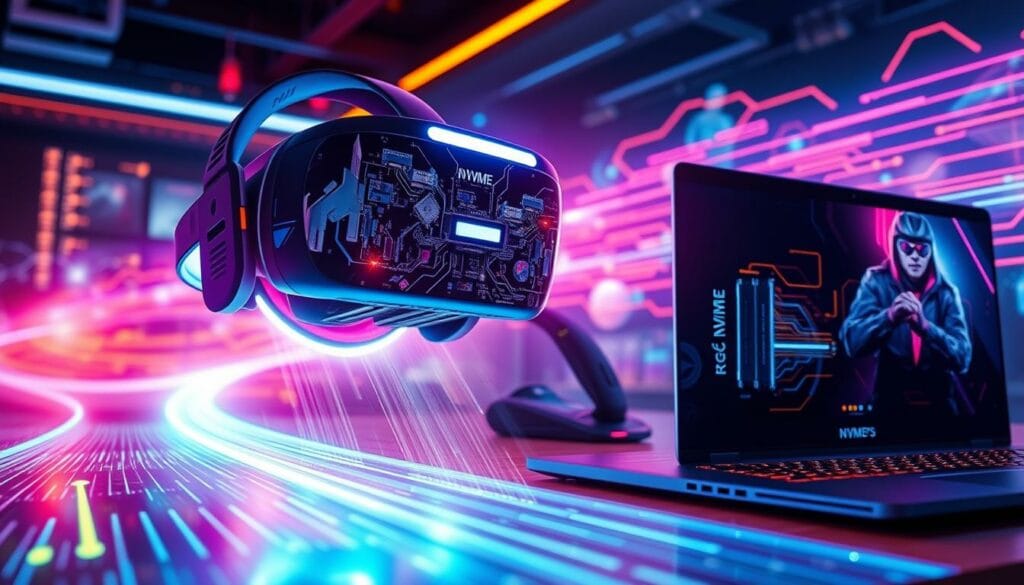
This speed is a lifesaver for professionals using VR too. Imagine architects walking clients through detailed virtual buildings or engineers tweaking complex product designs in VR. NVMe SSDs let them work with these huge models smoothly, making them more productive and their VR tools far more effective.
| Metric | AHCI Drives (Older SATA) | NVMe Drives (PCIe 5.0 potential) |
|---|---|---|
| Data Transfer Speed | Up to ~600MB/s | Up to ~32,000MB/s |
| IOPS (Input/Output Ops per Sec) | Up to 100,000 | Over 1,000,000 |
| Latency (Delay) | Around 6 microseconds | Around 2.8 microseconds (or less) |
NVMe SSDs truly let VR reach its potential, making interactions feel instantaneous and environments load without a hiccup. It’s all about crafting a more believable and engaging virtual escape.
Choosing Your Weapon: Picking the Right NVMe SSD for VR
Okay, so you’re sold on NVMe. But which one should you get for your VR setup? It’s a pretty important choice! You’ll want to balance speed, reliability, and enough space for those hefty VR games and apps. Some popular choices that often come up include the Samsung 980 PRO (often found in 1TB), the Western Digital WD Black SN850X (a real gaming favorite), and the Acer Predator GM7. These drives generally offer fantastic speeds, good capacity options, and sometimes have features to help manage heat, which keeps performance steady during long VR sessions.
That WD SN850X is particularly popular with gamers, and you can often grab it with a built-in heatsink (a little metal piece that helps dissipate heat). Just be aware, some folks mention the heatsink version can be a tight fit in some laptops or smaller cases. When browsing, many VR users find the 1TB versions of these drives hit a nice sweet spot between having enough space and not breaking the bank.
If you’re putting together a new desktop VR machine or upgrading an existing one, something like the Acer Aspire TC 1780 UA92 can be a great starting point. It typically has a capable processor (like the Intel Core i5-13400) and RAM you can easily upgrade (often from 8GB up to 32GB). Plus, desktops usually have plenty of ports, making it easy to plug in your headset, sensors, and other VR gear.
Finding the best bang for your buck is key. Compare prices online, check reviews to see how drives perform in real-world VR scenarios, and see if models like the Samsung 980 PRO or Acer Predator GM7 come with a heatsink or if you might need to add one separately (especially for intense use). A little research helps you balance raw speed, keeping things cool, and what fits your budget.
| SSD Model Example | Common Capacity | Approx. Read Speed | Approx. Write Speed | Heatsink Option? | Example Price Range |
|---|---|---|---|---|---|
| Samsung 980 PRO | 1TB | ~7,000 MB/s | ~5,000 MB/s | Available Separately/Included | ~$100 – $150 |
| WD Black SN850X | 1TB | ~7,300 MB/s | ~6,600 MB/s | Often Included/Available | ~$120 – $170 |
| Acer Predator GM7 | 1TB | ~7,400 MB/s | ~6,300 MB/s | Often Included/Available | ~$100 – $140 |
Heads up: Prices are just estimates and change all the time!
By thinking carefully about speed, cooling, and cost, you can snag the perfect NVMe SSD to supercharge your VR workstation and make those virtual worlds feel incredibly immersive.
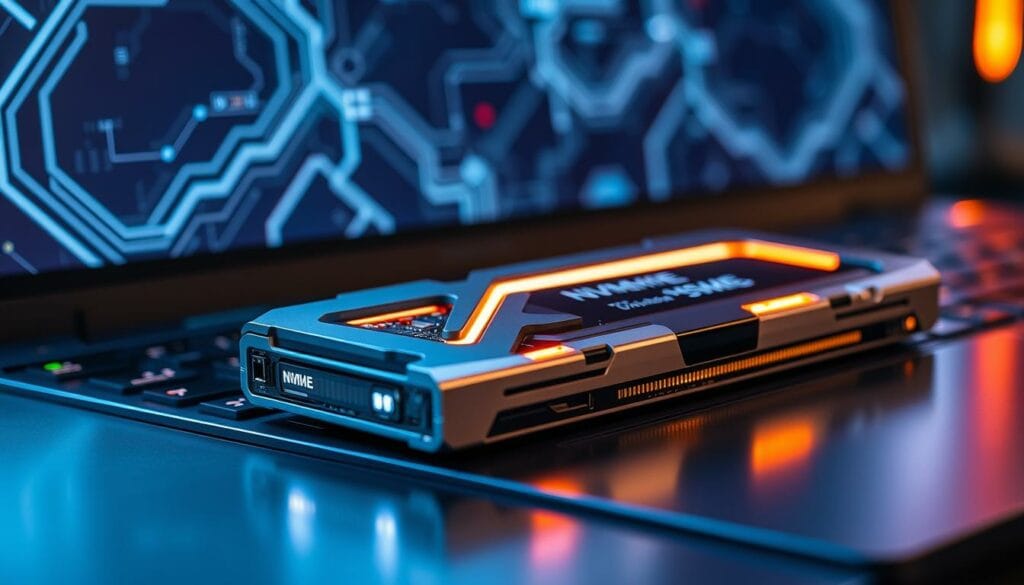
Supercharge Your VR Fun with NVMe Storage
Let’s just say it plainly: NVMe SSDs are pretty much essential if you want the best possible VR experience. For the folks actually building VR games and worlds, these drives are lifesavers because they access data so darn quickly. This means their development tools run faster, but more importantly for us, the games and virtual experiences they create load incredibly fast, getting rid of those immersion-killing loading pauses.
That quick loading translates directly into smoother gameplay and a world that feels more solid and real. You get less lag, action feels more fluid, and it’s just an all-around better time in the headset.
Now, pair a fast NVMe SSD with a powerful graphics card (GPU) – think something like the NVIDIA GeForce RTX 40 Series you find in many modern gaming laptops and desktops – and you’ve got a recipe for VR nirvana. This powerful combo lets you push the graphics settings higher in games or work with complex VR projects without sitting around waiting. Bonus points: many newer motherboards come with multiple M.2 slots, making it easy to add even more NVMe storage later if you need it.
| Feature | Benefit for Your VR Experience |
|---|---|
| High-speed NVMe storage | Slashes delays and load times for seamless VR fun. |
| NVIDIA GeForce RTX 40 Series GPUs | Delivers the graphics power for beautiful, smooth VR (thanks to cool tech like the Ada Lovelace architecture). |
| Dual M.2 slots (common feature) | Gives you room to easily add more super-fast storage for games and projects. |
Combining speedy NVMe drives with top-tier graphics really lets VR strut its stuff. It creates those incredibly immersive moments that truly pull you into another reality.
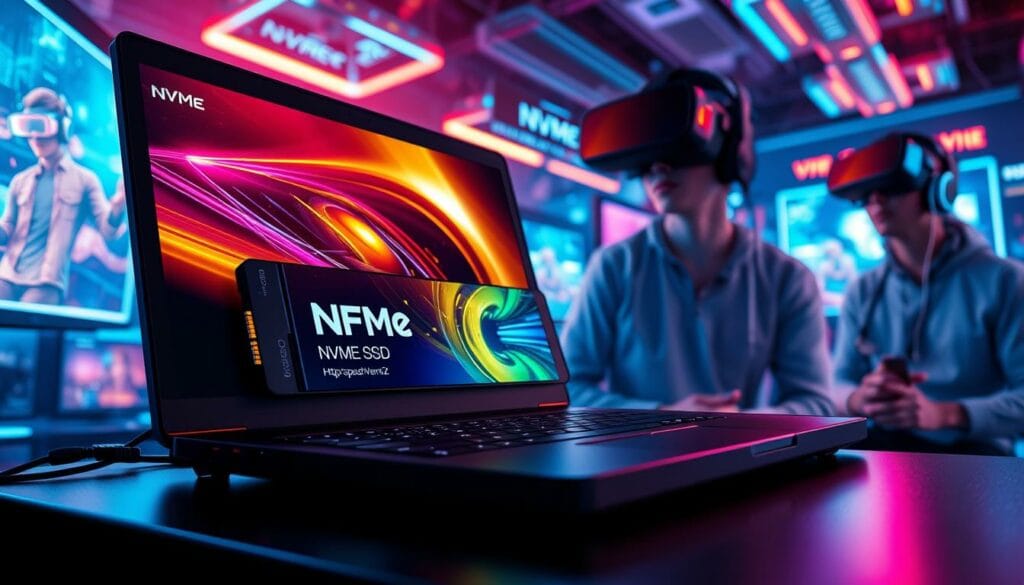
Got Room to Grow? How NVMe SSDs Keep Up with VR’s Ambitions
Virtual reality isn’t just sitting around – it’s constantly getting better! Headsets are showing us sharper images with higher resolutions, and the virtual worlds themselves are becoming packed with mind-boggling detail. All this cool progress requires more storage space and even faster performance from our computers. Luckily, NVMe SSDs are totally up for the job, offering the speed and capacity needed for both today’s VR and whatever amazing stuff comes next.
With current NVMe SSDs hitting data speeds over 7,000 MB/s, they can shovel data into your VR system incredibly quickly. This is super important in VR, where you need environments to load instantly and transitions to be seamless to stay immersed.
NVMe drives also come in much bigger sizes these days. Finding a 4TB drive is pretty easy, and even larger capacities are starting to pop up. What does this mean for you? You can install huge VR games, store detailed professional models for work, or keep tons of VR content handy without constantly juggling files or worrying about running out of space. That’s awesome news for both VR gamers and creators.
Adding NVMe SSDs to VR setups has been a genuine game-changer, making everything feel more responsive and convincing. As VR tech keeps racing forward, NVMe SSDs are ready to scale right along with it, ensuring that VR stays exciting, engaging, and breathtakingly immersive.
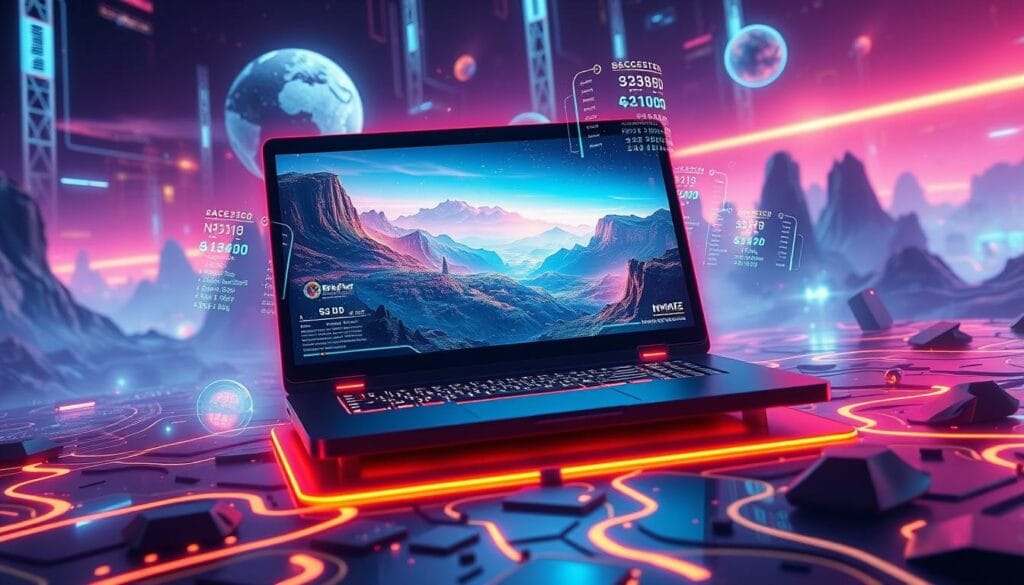
“The ability of NVMe SSDs to scale up is crucial for VR’s future, opening doors to new levels of immersion and performance we haven’t even seen yet.”
Basically, NVMe SSDs give VR the breathing room it needs to keep getting better. Their potent mix of high speed and large capacity makes them a fundamental piece of the puzzle for the future of virtual experiences.
More Than Just Games: NVMe SSDs Powering Professional VR
Don’t think NVMe speed is only for gamers! NVMe SSDs are making a massive impact in the professional world, too, helping people use VR for serious work across different industries.
Think about architecture and engineering. Using a super-fast NVMe SSD, maybe something like the Crucial T700, lets designers effortlessly glide through complex 3D building models in VR. No lag, no stutter – just smooth navigation that makes virtual walkthroughs with clients feel natural and helps get work done faster.
Over in the entertainment biz, VR production studios are leaning on drives like the WD_Black SN850P NVMe SSD. Why? Because handling enormous files, like crisp 8K VR video footage, becomes way easier and quicker. This lets filmmakers get really creative, building incredibly detailed virtual worlds without being held back by slow storage.
Even in medicine, NVMe SSDs are playing a vital role. Hospitals often use special workstations (called PACS) for viewing huge medical image files like X-rays and MRIs. These systems need lightning-fast storage so doctors can pull up patient scans instantly. NVMe SSDs deliver that crucial speed, often working alongside fast network connections.
Manufacturing is another hot spot. Engineers use VR to create virtual prototypes, letting them examine and collaborate on 3D product designs before anything physical is built. The instant access and near-zero delay from NVMe storage make these VR design sessions much more effective, allowing for quick changes and better teamwork.
These examples show clear, practical benefits: NVMe SSDs help professionals work faster, smoother, and produce higher quality results using VR. As virtual reality becomes a more common tool in various fields, fast NVMe storage will continue to be absolutely essential for driving innovation.
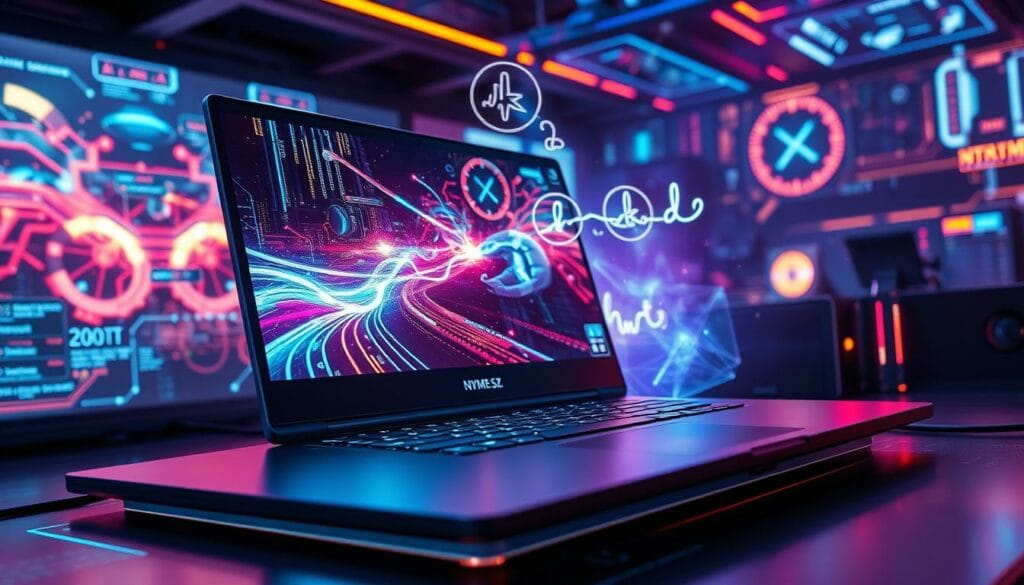
What’s Around the Corner? Faster NVMe and the Future of VR Storage
Virtual reality tech is moving incredibly fast, and storage technology is sprinting to keep pace. The future looks even speedier, thanks to ongoing improvements in NVMe and some really interesting new storage ideas popping up.
We’re already starting to see PCIe 5.0 NVMe SSDs appearing, promising truly mind-boggling data speeds – potentially hitting up to 32,000 MB/s! Imagine VR worlds loading literally instantaneously. That kind of speed will make future VR systems feel incredibly responsive, further blurring the line between what’s virtual and what’s real.
And it might not stop there. Beyond the flash memory used in today’s NVMe drives, researchers are working on other technologies. Stuff like 3D XPoint (which powered Intel’s Optane memory, though its future is a bit cloudy) and possibly brand-new memory types could offer even faster data access and lower delays than current NVMe. As VR pushes towards photorealistic graphics and instant interaction, these futuristic storage solutions could be the key.
The future of storage for VR is definitely exciting! Driven by even faster NVMe drives and maybe some revolutionary new tech, these advancements will enable deeper immersion and more complex virtual experiences than we can currently imagine.
| Future VR Storage Tech | Key Features | Potential Impact on Your VR |
|---|---|---|
| PCIe 5.0 NVMe SSDs | Insanely fast speeds (up to ~32,000 MB/s) | Makes VR hyper-responsive for truly seamless immersion. |
| Emerging Memory Tech (like 3D XPoint successors) | Potentially even quicker access & lower delay | Could totally change storage for ultra-realistic virtual worlds. |
As storage gets faster and smarter, it’s going to unlock VR experiences that feel like science fiction today. Less waiting around, more exploring – that’s the direction we’re headed!
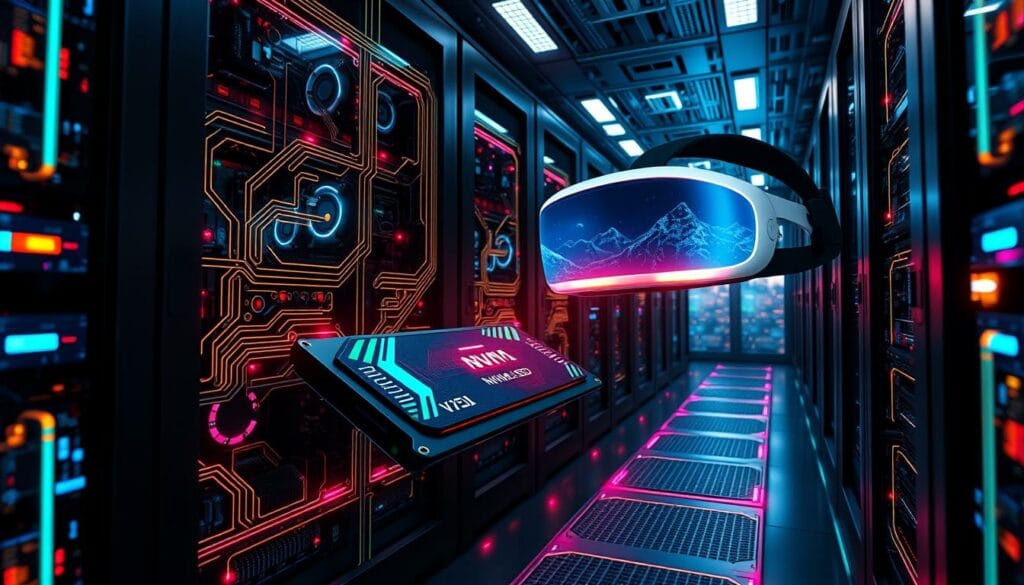
“The future of VR storage isn’t just about raw speed; it’s about crafting experiences that feel utterly seamless and totally immersive. By harnessing the latest leaps in NVMe and exploring new storage possibilities, we can keep pushing the limits of virtual reality.”
Wrapping It All Up: NVMe is Your Ticket to Great VR
So, what’s the big takeaway? NVMe SSDs have absolutely revolutionized virtual reality. By delivering those super-fast data speeds and kicking annoying delays to the curb, they make VR feel way more real, run much smoother, and become far more engaging. Honestly, they’re a fundamental upgrade for any serious VR system, making games load in a snap and run without those immersion-breaking hiccups.
And this story is still unfolding! As VR technology keeps getting more amazing, NVMe SSDs and whatever cool storage tech comes next will keep evolving right alongside it. They’re paving the way for even more jaw-dropping virtual experiences in the years to come.
Put simply: NVMe SSDs are vital for VR’s success. They provide the critical speed and growing capacity that modern VR absolutely demands, making virtual worlds more immersive, exciting, and believable than ever before. If you’re diving into VR, an NVMe SSD isn’t just a ‘nice-to-have’ – it’s pretty much essential!
Source Links
- ROG’s GeForce RTX gaming laptop guide: meet the latest generation of a growing family – https://rog.asus.com/articles/rog-gaming-laptops/rogs-geforce-rtx-gaming-laptop-guide-meet-the-latest-generation-of-a-growing-family/
- Most Expensive Gaming Laptops 2024: Rankings & Insights – https://www.linkedin.com/pulse/most-expensive-gaming-laptops-2024-rankings-insights-james-alexander-cnv3e
